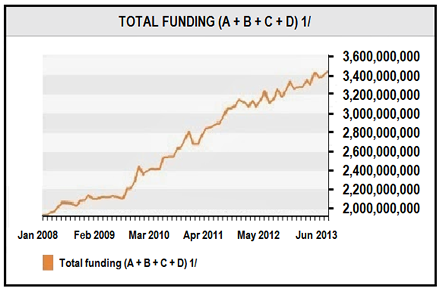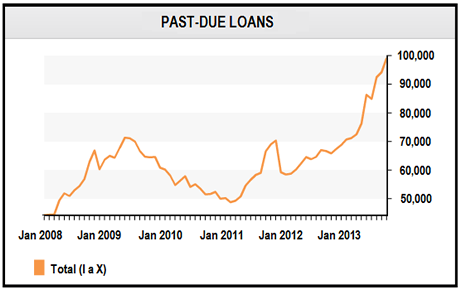Today's world is mired in such a spiral of financial and economic corruption, that surely it will not be able to emerge from it without suffering the consequences.
One of the key symptoms of this structural disease is the exponential growth of debt that, with ever-increasing difficulty, keeps the system afloat.
Nonetheless, world governments in both “developed” and “developing” countries are now irrationally and unreasonably committing the same mistakes that, in the past, led Mexico to such financial crisis and economic weakness, as now prevails in the world.
A global problem caused by excessive debt, consumption and credit cannot be resolved with more of the same.
However, the prevailing “sophisticated” economic theories, that monetarists and Keynesian economists swear by, has them convinced that someday the economy will react to the spending, debt-increasing and money-printing stimulus, and if it doesn’t, such activities will have to be stepped up another notch, and another and another. This is utter nonsense.
Nonetheless, on November 26th, Mexico officially joined this credit expansion policy through the Senate’s approval of the 'Financial Reform'.
The Mexican Government brags shamelessly about the objective of this reform: government wants banks to lend at “increasingly cheaper rates” with the simplistic argument that “they don’t lend enough.” Great!
The bad news is that the examples used to support this notion are related to nations that are currently in a worse economic and financial situation than ourselves, and certainly are not the best role models.
Besides, the statement that ‘banks are not lending enough’ is relative; the graph bellow shows that the volume of bank lending has been increasing.

Source: Banco de México. Figures in thousands of pesos.
The total amount that commercial banks have lent to the non-banking sector, including the private and public sectors, states, municipalities and “others”, continues to rise.
The rate of increase declined markedly following the onset of the 2008 financial crisis and the 2009 recession; however, since then we began to see a clear, albeit fluctuating, upward trend, until the most recent preliminary data: 3.45 trillion pesos (up to September, 2013). So, the amount has increased by almost 80 percent between January 2008 and September 2013.
Unfortunately, this policy led to an increasing amount of past-due loans, which are now at their highest rate since December 2003. A 10-year high. Up to September 2013, past-due loans in all currencies (domestic and foreign) stood at nearly 99 billion pesos (see graph).

Source: Banco de México. Figures in millions of pesos.
In other words, the financial reform comes at a time when banks may be realizing that they have been lending too much, in light of increased borrower defaults. What will happen when the government starts to pressure them to continue lending?
This is not a purely hypothetical question.
In fact, the main reason why the reform represents a menace to the nation is that the Treasury Ministry has been vested with the ability to pressure commercial banking institutions if they do not act according to its wishes.
The Chapter Eight of the 'Credit Institutions Law', entitled “Performance Evaluation of Commercial Banking Institutions”, deals with this subject.
Of course, that means that if they do not open their credit flows to the extent the government would like to see, then the Treasury, the Banking Authorities and the Mexican Central Bank may punish them – and even refuse them license to operate. So, they will have to 'behave properly', according to the Executive Branch’s view.
Article 276 in this same section, unequivocally states that the performance of the banks will be evaluated according to their trend and compliance with “supporting and promoting the country’s productive sector and domestic economic growth.”
Despite the fact that the law stipulates that the Ministry of Finance must do this in accordance with sound banking practices and customs, it also opens the door to “other discretionary aspects” that may be determined by the government entity itself. So, the banks’ freedom to invest and engage in risk analysis will be tossed on the scrapheap.
It is no coincidence that in case of negative evaluation results, Article 53 of the Law sets “parameters for such institutions to participate in securities transactions on their own behalf, which may also be differentiated according to each type of security.”
Clearly, the Finance Minister, Luis Videgaray, will now be vested with powers Mexico has not seen since at least the seventies or the eighties, which always —and not coincidentally— drove the country over the cliff into recurrent crises.
Peña Nieto’s first year in office has been downright disappointing from an economic point of view, and now there is also the risk that Government may decree an economic jump-start charged to the “credit card”, both in public and private sectors.
We must not forget that a dangerous and populist tax reform was recently approved, in addition to a financial budget which opens wide the gate to government deficit - which we advise you will continue throughout Peña Nieto’s entire term of six years.
What about promoting a savings culture as a State policy? Not a word.
So, the table is set for a banquet and a binge that is likely to be short-lived. History, it is clear, has taught us nothing.





![[Most Recent Quotes from www.kitco.com]](http://www.kitconet.com/charts/metals/silver/t24_ag_en_usoz_2.gif)
![[Most Recent Quotes from www.kitco.com]](http://www.kitconet.com/charts/metals/gold/t24_au_en_usoz_2.gif)